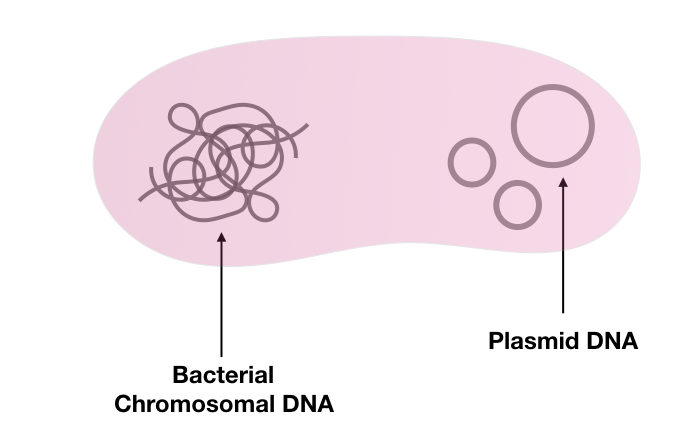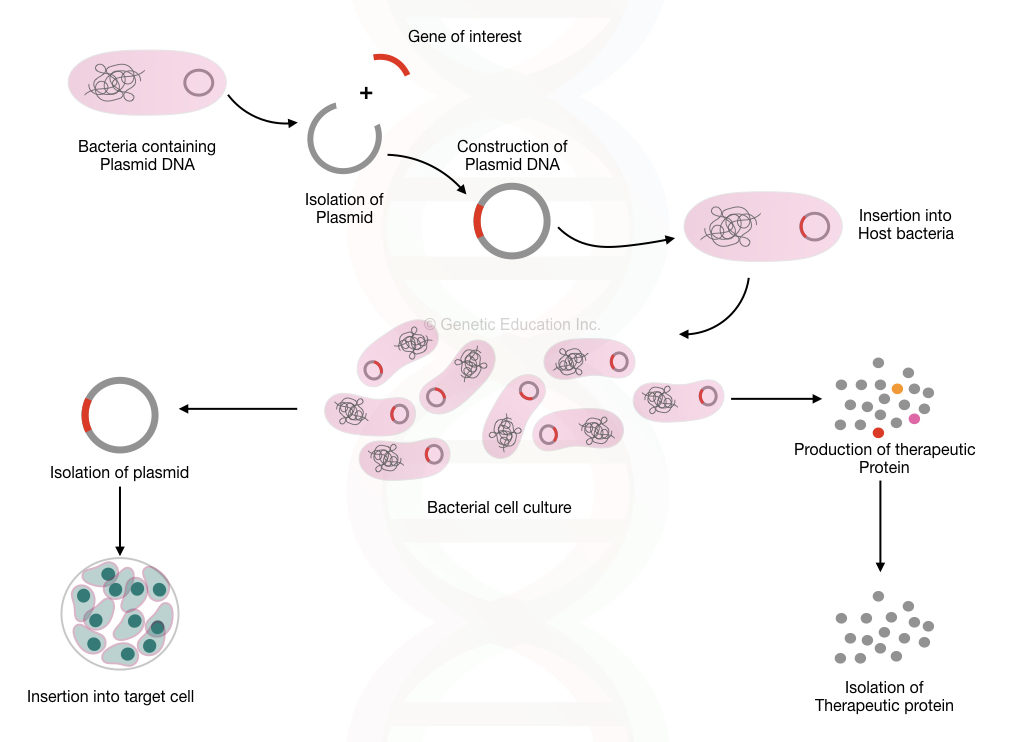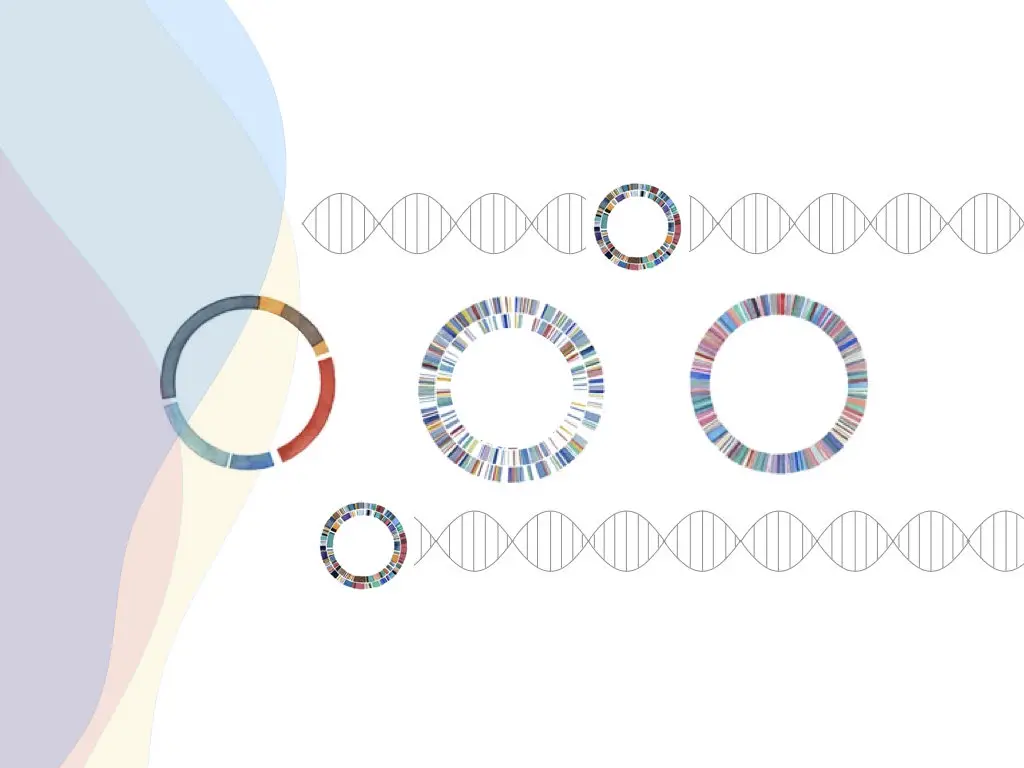“The plasmid DNA is a bacterial smaller, circular and extrachromosomal DNA, replicate independently- used in the genetic engineering and recombinant DNA technology.”
The unique property of self-replication makes it unique and available to use in different molecular genetic research such as gene therapy, gene transfer and recombinant DNA technology.
A gene of interest or a therapeutic gene is inserted in a plasmid DNA and transferred into the target cell for studying the function or expression of a gene.
For a molecular geneticist, it is very important to understand what actually the plasmid DNA is and how scientists are using it.
The artificially synthesized plasmid DNA is a key ingredient for the production of Genetically modified plant species, therapeutic drugs and proteins.
In the present article, we will talk about plasmid DNA and how it is used in recombinant DNA technology.
Furthermore, we will understand how to construct it and what are the different types of plasmids used in the different experiments.
So let’s start with some basic information on a plasmid,
Key Topics:
What is plasmid DNA?
A cell is a building block of life on earth, some organisms are unicellular- only have a single cell and some are multicellular- contains many cell types.
The unicellular organisms are called prokaryotes and the multicellular organisms are called eukaryotes.
Bacteria and viruses are common prokaryotes.
The bacteria is a single-cell organism that has a bacterial chromosome made up of DNA as its genetic material.
Besides this, the bacteria also contain a circular DNA in the cytoplasm of the cell called plasmid DNA.
The plasmid DNA contains several important genes for the survival of bacteria.

Definition of plasmid DNA:
“A circular double-stranded DNA present in the cytoplasm of a bacteria that replicate independently from the bacterial chromosome is called a plasmid DNA.”
Plasmid DNA is also present in some smaller eukaryotes and archaea.
Properties of the plasmid DNA:
The plasmid DNA has several distinct properties which make it unique in nature.
The plasmid DNA is a circular molecule made up of double-stranded DNA.
It is considered as replicons– contains an origin of replication, thus it is self-replicating.
It contains an antibiotic resistance gene for the survival of bacteria which helps in developing resistance against some natural antibiotics.
Copy number of plasmids: smaller plasmids are few in number and only a single larger plasmid is present in each bacterium.
The size of the plasmid varies from several Kelo basepair to several megabase pairs, depending on the type of plasmid.
One of the important properties of the plasmid DNA is the horizontal gene transfer through the process of conjugation.
The plasmid is a self-replicating element that is inherited in each bacterium during cell division.
The size of the plasmid DNA is generally 1kb to 2 kb (used in genetic research), the smaller size of it makes it easy to create and modify for genetic engineering.
Also, the stability of the plasmid DNA is very high. It can remain stable for a longer period of time as in a purified state or in the bacterial cell.
The plasmid can be used in many different types of species for gene transfer and gene therapy experiments.
Structure of plasmid DNA:
As we said, a plasmid is circular DNA that possesses several important genes and DNA sequences that are not present in a bacterial own chromosome.
The plasmid DNA contains an origin of replication, antibiotic resistance gene, promoter sequence and restriction digestion site.
Function of the plasmid DNA:
The plasmid DNA helps in the survival of the organism.
It kills other host cells by producing toxic proteins and also protects its own cells by developing resistance or killing the foreign organism.
The plasmid also helps in replicating the bacterial DNA in some harsh conditions.
Some of the different types of plasmid-based on their function are given below,
F-plasmid-
Also known as the fertility plasmid is a type of conjugative plasmid that helps the bacteria to transfer genes through the process of conjugation.
Interestingly, only a single F plasmid is present in each bacteria, a bacterium carries the F-plasmid is known as F+ and the rest are F-.
Conjugation between the F+ and F- plasmid results in two F+ plasmid production that gives power to bacteria for doing conjugation.
The F plasmid is smaller in size and does not have its own replication set up thus it is an episome that is inserted into the bacterial chromosome for doing replication and transcription.
Col plasmid-
The col plasmid is another smaller type of plasmid that contains the DNA sequences for Col which encodes the colicin, this protein protects the bacteria from the other pathogenic attacks.
The col plasmid helps in defending the host.
R plasmid-
Also known as the resistance plasmid possesses the genes for the natural antibiotic resistance and protects the host from the antibiotic effects.
Also, the R plasmid can be transferred to another bacteria through the process of conjugation.
V plasmid-
Also known as the virulence plasmid developed when the bacteria become pathogenic. This type of plasmid contains a bacterial strain that spreads diseases.
D plasmid-
Often known as the degradative plasmid which helps bacteria to digest or destroy the harmful unnatural compound that possibly harms it. Such plasmid digests xylenes, salicylic acid and toluenes.
Broadly we can say the role of each type of plasmid is either to protect the host or to do the reproduction.
Plasmid DNA and recombinant DNA technology:
The plasmid DNA is one of the important ingredients in recombinant DNA technology and in gene transfer experiments.

In molecular genetics, it is known as “vector” or “construct” which helps in transferring the gene of interest at the target location or we can say it is used as a vehicle to transfer the gene of interest at the specific location for artificial gene transfer or for the development of the therapeutic proteins.
This is the general overview of the plasmid and plasmid DNA, now let’s quickly move to the important part of the article that is, how the plasmid DNA is constructed to use in molecular genetic experiments and what are its applications of it.
Related articles:
- Gene Therapy: Types, Vectors [Viral and Non-Viral], Process, Applications and Limitations.
- What is Gene Therapy? and How Does it Work?
- Naked DNA Mediated Gene Therapy
How to construct a plasmid DNA?
For using the plasmid in the cloning experiments, the plasmid must have several sequences required to perform the function.
It must have the ORI sequence (origin of replication), marker sequences, antibiotic resistance sequences, multiple cloning sites, promoter regions, restriction digestion sites and primer binding sites.

Several sequences must be present in the plasmid DNA are given below,
ORI- the plasmid has its own replication and transcription mechanism for that it has the DNA sequences that facilitate autonomous replication of plasmid DNA. These sequences are called the origin of replication or ORI.
Antibiotic resistance gene- the antibiotic resistance gene is one of the unique properties of the plasmid.
The antibiotic resistance gene present in the plasmid helps the bacteria in survival and protects them from the antibiotics.
Interestingly, the plasmid itself originates different antibiotic genes when it comes in contact with different antibiotics.
Restriction site- often known as multiple cloning sites, the plasmid also has unique sequences that contain restriction digestion. The restriction site is used for the insertion of a gene of interest during the experiment.
For that, the plasmid is digested with the help of the unique restriction enzyme having only a single digestion site on the plasmid.
Promoter region- the promoter region facilitates transcription of target DNA.
Selectable marker- the selectable marker allows the selection of bacteria containing the gene of interest.
It is used in studying and manipulating the gene or the gene of interest.
For performing any of the gene cloning experiments we must have to isolate plasmid before constructing it.
Isolation plasmid DNA:
(this section contains a brief overview of the plasmid DNA isolation)
Isolating the pure form of the plasmid DNA is one of the crucial steps in molecular cloning experiments.
For that, first, the bacteria containing plasmid DNA are cultured using the standard bacterial culture procedure.
Using the alkaline lysis and detergent methods the plasmid is isolated. The SDS is commonly used for that.
Now it is necessary to isolate plasmid DNA from the bacterial chromosomal DNA. And for that ready to use plasmid DNA extraction kit is used.
Using the miniprep plasmid DN isolation kit, the plasmid DNA is isolated.
Purification of plasmid DNA:
A standard phenol-chloroform method can be used for the isolation and purification of the plasmid DNA, however, it is not recommended because of the cruciality of the experiments.
The spin-column method of plasmid DNA purification is used instead, which gives higher yield and higher purity.
Besides this, the most common ethanol precipitation method can also be used for the purification of plasmid DNA as well.
Constructing plasmid DNA
For the construction of plasmid DNA, in the beginning, the DNA of our interest is isolated from the genome.
Using the restriction digesting method followed by the PCR amplification, multiple copies of the gene of interest are generated.
Now the plasmid DNA is digested using the restriction endonuclease enzyme which creates the same sticky ends alike the gene of our interest.
Once it has been done, along with the gene of interest, the promoter site (for performing replication) is inserted into the plasmid using the ligation method.
Enzyme ligase is used to seal the ends of the plasmid DNA and insert (Ligase).
Once the process of plasmid construction is done, the plasmid DNA is amplified or can directly be inserted into the bacterial host.
In general, E.coli is used for transformation experiments.
The bacterial containing artificial plasmid is grown using the standard culturing procedure.
Once, a sufficient amount of bacterial colonies are cultured, the plasmid DNA is isolated.
Now the plasmid DNA is inserted into the target cell population in which we want to transfer our gene of interest.
(Or we can extract the therapeutic protein from it.)
There are many methods for gene transfer are available.
Electrophoration, sonication, liposome-mediated gene transfer and viral-vector-mediated gene transfer are some of them.
After the insertion, the plasmid DNA was incorporated into our genome and replicated naturally.
This is the general outline of the use of plasmid DNA in gene transfer and gene therapy experiments.

Type of plasmids:
Cloning plasmid:
One of the simplest plasmids used in the cloning experiment is cloning plasmid only contains an antibiotic resistance gene, the origin of replication and MCS.
Viral plasmid:
A modified viral genome is used as a viral plasmid for delivering a gene of interest into the host genome. The viral plasmid is applicable in gene therapy experiments. AAV and retrovirus are commonly used.
Reporter plasmid:
This type of plasmid is used to study the function of a gene.
Expression vector:
This type of vector/ plasmid is used to study the expression of a gene of our interest.
Applications of plasmid DNA:
As we explained in the above section, the plasmid DNA is used in gene therapy to transfer a gene of interest in a specific cell type.
Prevention of disease:
Using gene therapy techniques, single-gene disorders are now can be prevented.
Therapeutic drugs and proteins:
One of the classic examples of the use of plasmid or vector DNA in recombinant DNA technology is for the production of insulin.
Therapeutically important drugs and proteins are synthesized artificially- outside the cell using the plasmid DNA.
Gene transfer experiments:
The recombinant DNA method is also used to transfer the gene for various purposes such as for constructing GMO, GMP and other resistant species of plants.
The plasmid DNA is also used in the gene knockout study and construction of knockout mice.
Besides this, the plasmid DNA is also used in gene mapping and gene cloning as well.
Further read: A Brief Introduction to “Gene Mapping”.
Conclusion:
Plasmid DNA is one of the important elements in genetic research. Scientists are now trying to use the viral vectors or other plasmid DNA-mediated gene therapies for preventing diseases like cystic fibrosis or Huntington’s disease.
However, the nonexpression behavior of plasmids and the side effects of using viral vectors are the two biggest challenges for scientists.
Resources:
- Margo R Monroe. Plasmids 101: What is a plasmid? by the addgene blog, 2014.
- Carsten Voss. Production of plasmid DNA for pharmaceutical use. Biotechnol Annu Rev. 2007; 13: 201–222


